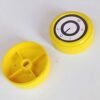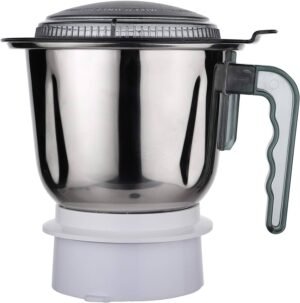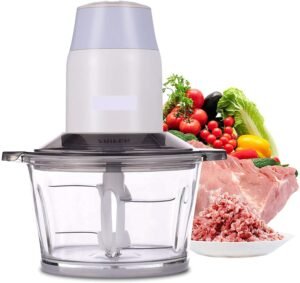Blender Chopper Speed Control Knob
₹312.00 Original price was: ₹312.00.₹260.00Current price is: ₹260.00.
Introduction to Blender Chopper Speed Control
Understanding the speed control knob on a blender chopper is essential for maximizing its utility in culinary tasks. The speed control feature allows users to adjust the rotational speed of the blades, which directly influences the texture and consistency of the ingredients being processed. This functionality is crucial for various cooking techniques, such as chopping, dicing, blending, or pureeing different foods.
A chopper equipped with a speed control knob provides the flexibility to achieve a range of textures from finely minced vegetables to coarsely chopped herbs. By varying the speed, users can manipulate the cutting action; for instance, a slower speed may be ideal for slowly breaking down soft ingredients, while faster speeds are better suited for tougher items. This control can result in a superior end-product tailored to specific recipes and personal preferences.
Additionally, this versatile feature allows for experimentation in the kitchen. Chefs and home cooks alike can explore new techniques and flavors by manipulating the speed settings. Whether preparing sauces that require smooth emulsification or chunky salsa, a propane chopper with a speed control knob ensures that anyone can achieve their desired results. Ultimately, mastering the speed control is an integral part of leveraging the full potential of your blender chopper in food preparation.
How the Speed Control Knob Functions
The speed control knob in a blender chopper serves as a vital component that allows users to adjust the blending or chopping speed according to their specific needs. At its core, the knob operates through a combination of mechanical and electronic systems, all of which work together to enhance the functionality of the blender chopper. The primary function of the speed control knob is to regulate the power delivered to the motor. This adjustment enables the appliance to achieve various operational speeds, ranging from a gentle slow mix to a high-speed tumultuous blend.
In essence, when the user turns the speed control knob, it manipulates a potentiometer or a similar electronic component. This action alters the electrical resistance, thereby adjusting the voltage and current supplied to the motor. Consequently, this modification in power output enables the motor to either speed up or slow down the blades’ rotation, resulting in different blending effects. The integration of gears in the assembly also plays a role, amplifying the mechanical advantages and ensuring the blades can handle thick or fibrous ingredients more efficiently.
The relationship between speed settings and chopping efficiency is significant. Lower speed settings are typically better suited for gentle mixing, emulsifying liquids, or pureeing soft ingredients. In contrast, higher speed settings excel at pulverizing harder foods or achieving finer textures. Understanding the functionality of the speed control knob not only enhances the user experience but also optimizes the outcomes of culinary endeavors. Mastering this component ultimately enables users to take full advantage of their blender chopper’s capabilities for an array of food preparation tasks.
Choosing the Right Speed for Different Ingredients
Selecting the appropriate speed on your blender chopper is essential to achieving the desired texture and consistency for various ingredients. Understanding the interplay between speed and food type can significantly enhance your culinary results. Generally, blenders and choppers are equipped with multiple speed settings, each optimized for different tasks. Knowing when to adjust these settings can make all the difference in food preparation.
For finely chopping herbs, a low to medium speed is often ideal. At these lower speeds, the blades of the chopper can slice through the delicate leaves effectively without bruising them, allowing for an even consistency. For example, when chopping basil or parsley, a pulse setting at low speed will help achieve a fine chop without turning the herbs into a paste.
When it comes to blending smoothies, a higher speed is required to break down tougher ingredients such as frozen fruits or leafy greens. The ideal setting for this task is often the highest speed, ensuring that the blades can circulate the mixture efficiently, creating a smooth and creamy texture. Starting at a lower speed before gradually increasing can assist in preventing large chunks from forming.
Pureeing vegetables presents another scenario where speed selection is crucial. For softer vegetables like cooked carrots or squash, a medium speed is typically effective, allowing the blades to create a silky, uniform puree. However, for firmer vegetables like raw potatoes, you may want to first chop them into smaller pieces and then use a higher speed for better results.
Experimenting with different speed settings during cooking can help you discover the optimal blend for your dishes, catering to your personal taste preferences and specific ingredient characteristics. Over time, developing a keen sense of which speed works best for various tasks will enhance your overall cooking experience.
Common Issues and Solutions with Speed Control Knobs
The speed control knob on a blender chopper is an essential feature that allows users to adjust the blending intensity and achieve desired consistency. However, various problems can arise, affecting its performance. One common issue is inconsistent speeds, where the blender may fail to maintain a consistent power level during operation. This can be caused by wear and tear within the knob mechanism or improper connection to the motor. Users experiencing this issue should first check for loose connections or debris that may obstruct functional components. Regular cleaning of the knob and surrounding areas can prevent build-up that usually leads to inconsistent performance.
Another prevalent concern is knob stiffness. Users may find it difficult to rotate the speed control knob, leading to frustration during blending tasks. Stiffness can result from accumulated dirt, grease, or even damage to the knob itself. To remedy this, a simple cleaning routine can often restore its functionality. For those who prefer a more thorough approach, lubricating the knob with a food-safe lubricant may alleviate the stiffness, ensuring smoother adjustments during operation.
In some instances, the speed control may become entirely unresponsive, indicating a malfunction. This problem can stem from electrical issues or damaged internal components. Users should first examine the power supply, ensuring that the blender is properly plugged in and functional. If the issue persists, it may be time to consult the manufacturer’s guidance or seek professional repair services. In cases where the cost of repairs exceeds the price of a replacement unit, considering a new blender chopper may be a more prudent solution.
Proactive maintenance, including regular inspections and timely cleaning, can substantially extend the lifespan of the speed control knob while mitigating common issues.
Maintaining Your Blender Chopper’s Speed Control Knob
To ensure the longevity and efficiency of your blender chopper’s speed control knob, regular maintenance practices are essential. The speed control knob is a critical component of the appliance, allowing users to adjust blending intensities and textures. Consequently, neglecting its upkeep may lead to malfunction, diminished performance, or even permanent damage.
One of the first steps in proper maintenance is to regularly clean the speed control knob. Residue from blended ingredients can accumulate around the knob, potentially hindering its functionality. Clean the knob using a soft cloth dampened with a mild detergent solution. Ensure the knob is turned off before attempting to clean it. Avoid abrasive cleaners or scouring pads, as these can scratch and damage the surface of the knob. Afterward, dry the area thoroughly to prevent moisture from seeping into the mechanism.
Additionally, implement a routine inspection to catch any signs of wear or tear. Periodically check the knob for cracks or loose fittings that may affect its operation. If you notice incongruities, it is prudent to seek professional servicing or consult the manufacturer’s guidelines to ascertain whether repairs are possible. This routine can help maintain the integrity of the speed control feature, promoting overall appliance efficiency.
Using the blender chopper correctly can also safeguard the speed control knob. Avoid excessive force when turning the knob, as this can lead to mechanical stress. Adhere to the recommended operational guidelines for your specific model, staying within the designated speed ranges indicated in the manual. Avoid prolonged operation at extreme settings, as this can strain the motor and speed control mechanism over time.
By following these maintenance practices, you can ensure that your blender chopper remains in optimal working condition, maximizing both the performance of its speed control knob and the appliance as a whole.
| Blender Chopper Brand Name | Bajaj, Bosch, Havells, Inalsa, Kenwood, Morphy Richards, Panasonic, Philips, Prestige, Wonderchef |
|---|
Only logged in customers who have purchased this product may leave a review.
Related products
-
Blender Chopper Parts
Blender Choppers Gaskets/O-Rings
Rated 0 out of 5₹234.00Original price was: ₹234.00.₹195.00Current price is: ₹195.00. Select options This product has multiple variants. The options may be chosen on the product page -
Blender Chopper Parts
Blender Chopper Jar Lid/Cap
Rated 0 out of 5₹468.00Original price was: ₹468.00.₹390.00Current price is: ₹390.00. Select options This product has multiple variants. The options may be chosen on the product page -
Blender Chopper Parts
Blender Chopper Jars and Bowls
Rated 0 out of 5₹1,465.00Original price was: ₹1,465.00.₹1,221.00Current price is: ₹1,221.00. Select options This product has multiple variants. The options may be chosen on the product page -
Blender Chopper Parts
Blender Chopper Bowl
Rated 0 out of 5₹780.00Original price was: ₹780.00.₹650.00Current price is: ₹650.00. Select options This product has multiple variants. The options may be chosen on the product page







Reviews
There are no reviews yet.